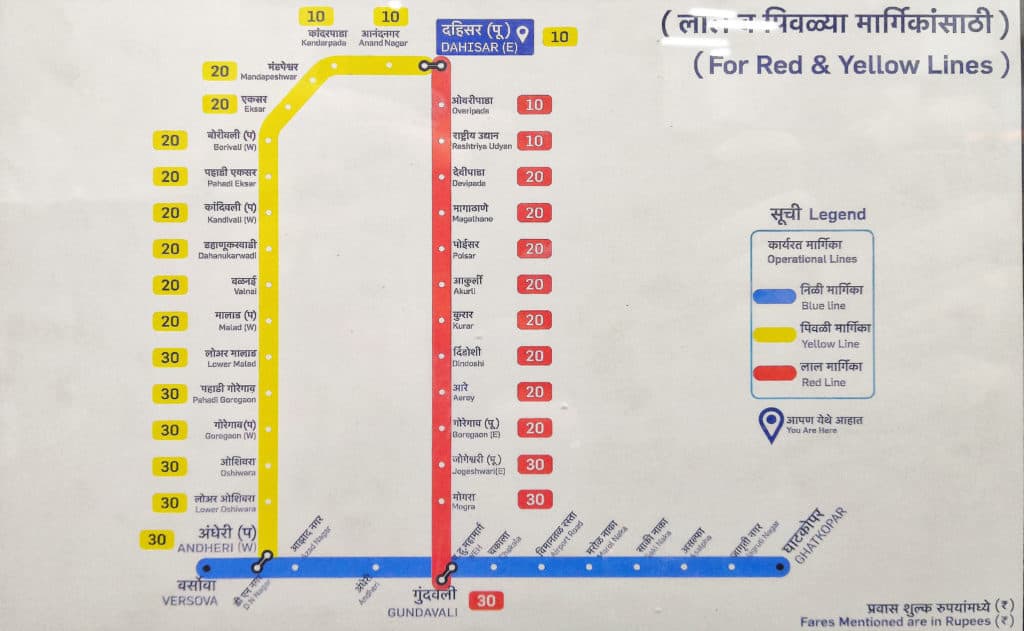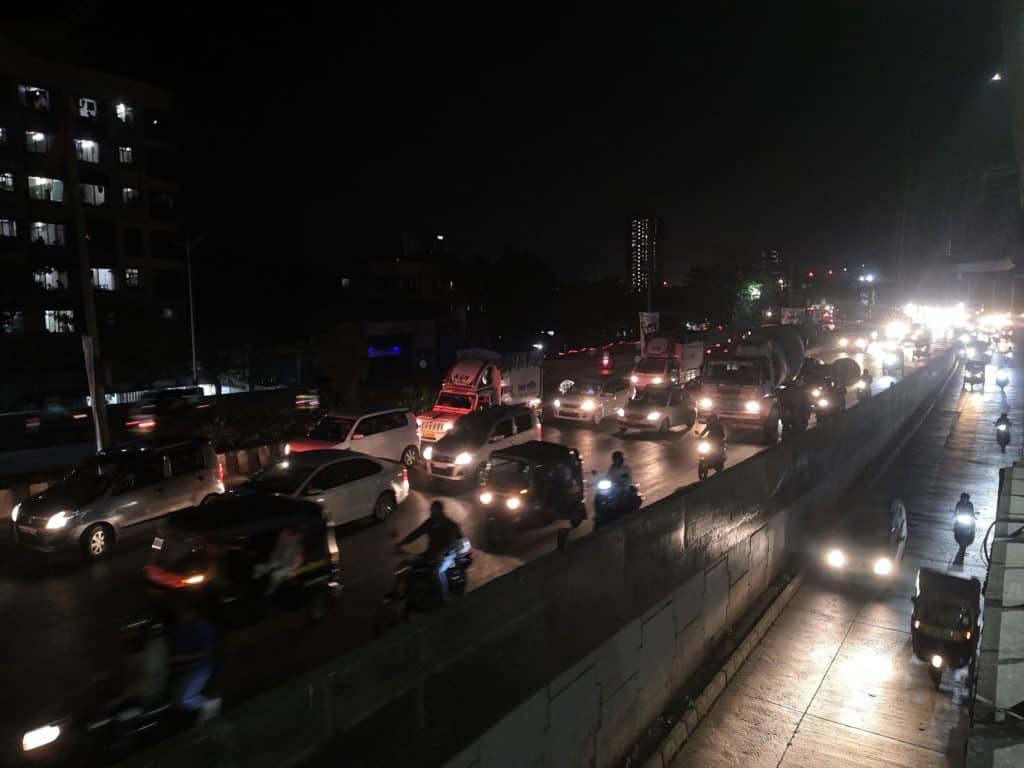It has been nine months after the partial start of Mumbai metro lines 2a and 7. With Prime Minister Narendra Modi inaugurating Phase 2 of the lines, Mumbaikars can now travel the length from Dahisar to Andheri within 40 minutes; on the west by Line 2a, or Line 7 in the east.
Running parallel to the Western railway line and Western Express Highway (WEH) at 80 km per hour, the six-car trains with a capacity of 2,280 passengers will easily be the faster and more comfortable option for travel. Their connection to the metro Line 1 running between Andheri to Ghatkopar also opens the east-west corridor to commuters. It is no surprise then that the Mumbai Metropolitan Region Development Authority (MMRDA) expects the ridership to grow tenfold; from a daily maximum of 30,000 to 3 lakh. By 2031, it is hoped the ridership will double to over 6 lakh for both lines each.
Some facts: The cost of a ticket will start at Rs 10 and go up to Rs 50 (A ticket will cost Rs 10 for a journey between 0-3 km, Rs 20 for 3-12 km, Rs 30 for 12-18 km, Rs 40 for 18-24 km, and Rs 50 for over. The first train will depart at 5:55 am, and the last will leave at 9:24 pm. The gap between trains will be 8 minutes at peak times, and Rs 10 at other times. With time and demand, this might change.
“The important thing is that for the first time in Mumbai we have a metro network,” says SVR Srinivas, metropolitan commissioner of the MMRDA. “That is a big thing.”

Upcoming summary
Mumbai’s fledgling metro network is a far cry from all that is planned: 14 lines, 300+ km, over 225 stations and multiple exchanges.
However, Mumbaikars are now at the cusp of another lengthy lull before any new metro transit corridors. “A lot of work is pending,” says Srinivas. “Many metro lines will open by the end of 2025, but we might be able to partially start some in 2024.”
| Line | Colour | Corridor | Length (Km) | Stations | Status | Launch |
| Line-1 | Blue | Versova – Andheri – Ghatkopar | 11.4 | 12 | Operational | 2014 |
| Line-2A | Yellow | Dahisar – DN Nagar | 18.6 | 17 | Operational | 2023 |
| Line-2B | Yellow | DN Nagar – Mandale | 23.6 | 20 | Under Construction | 2025 |
| Line-3 | Aqua | Colaba – BKC – SEEPZ | 33.5 | 27 | Under Construction | 2025 |
| Line-4 | Green | Wadala – Kasarawadavali | 32.3 | 30 | Under Construction | 2025 |
| Line-4A | Green | Kasarawadavali – Gaimukh | 2.9 | 2 | Under Construction | 2025 |
| Line-5 | Orange | Thane – Bhiwandi – Kalyan | 23.5 | 17 | Under construction | 2025 |
| Line-6 | Pink | Swami Samarth Nagar – Vikhroli | 14.7 | 13 | Under Construction | 2025 |
| Line-7 | Red | Dahisar – Andheri (E) | 16.5 | 14 | Operational | 2023 |
| Line-7A | Red | Andheri (E) – CSI Airport | 3.2 | 2 | Under Construction | 2025 |
| Line-8 | Gold | CSI Airport – NMIA | 35 | 7 | Planned | – |
| Line-9 | Red | Dahisar – Mira Bhayander | 11.4 | 8 | Under Construction | 2025 |
| Line-10 | Green | Gaimukh – Mira Road | 9 | 4 | Tendering | – |
| Line-11 | Green | Wadala – Chhatrapati Shivaji Maharaj Terminus | 12.7 | 10 | Tendering | – |
| Line-12 | Orange | Kalyan – Dombivali – Taloja | 20.7 | 17 | Tendering | – |
| Line-13 | Purple | Mira Road – Virar | 23 | 20 | Planned | – |
| Line-14 | Magenta | Kanjurmarg – Badlapur | 45 | 40 | Planned | – |
The current status and expected year of the launch of each Mumbai metro.
Partial opening in 2024 possible
Line 2B: Andheri West to Mandale, in the eastern suburbs
One of the lines that might see a partial start in 2024 is a crucial east-west connector, Line 2B. It will extend the newly operational Line 2A from its end in DN Nagar, Andheri West, to Mandale, Mankhurd, in the eastern suburbs. Along the way, it will intersect the forthcoming Line 3 in Bandra; Line 4 and the railways at Kurla; and meet the monorail in Chembur.
However, the in-demand east-west section will not be the first to start. Only 30% of the work on the line is done. 54% of civil work for the depot in Mandale – the largest in Mumbai – is complete. If Phase 1 sees its doors open in 2024, it will only be to connect DN Nagar to National College in Bandra.

Line 3: Colaba to BKC to SEEPZ
The past year has been eventful for the underground Line 3, to say the least. All the tunnelling is done; 50% of the track installation is complete; nearly 90% of the stations have been constructed. Bids for the extension to Navy Nagar were invited. A trial run with the first prototype rake was successfully completed, and a second train too has been delivered.
Work on the contested depot in Aarey – after being shifted over environmental concerns to Kanjurmarg, where it was stuck in litigation – is speeding along, currently standing at 37.8% complete from 30% when work on it was stopped.
Still, plenty of work on the highly anticipated line remains to be done. Phase 1, which may start by late this year or early next year, will traverse the portion between BKC and SEEPZ. Phase 2, till Cuffe Parade and eventually till Navy Nagar, will finally complete a viable alternative to the Western railways and Western Express Highway (WEH).
Line 4 and 4a: Wadala to Kasarvadavali to Gaimukh
Running parallel to Line 3 in the eastern suburbs is the green Line 4, travelling from Wadala in the south to Kasarvadavali, Thane, in the north. It will go along Ghatkopar, BS Marg and Ghodbunder Road till Kasarvadavali. An extension, Line 4a, will take it to Gaimukh. Along the way, it will intersect with the metro lines 2B, 5, 6, 8, the central railway and monorail.
43% of the civil work on the line is complete, indicating little progress from this time last year, when 40-50% of the work was claimed to have been done. Land acquisition for the depot in Mogharpada near Ghodbunder Road has been stuck for four years. This January, the MMRDA wrote to the revenue department asking to be allotted the land. Bids for the car shed have been issued. Fresh tenders for the rolling stock will also have to be recalled, as contracts were cancelled due to the sluggish progress.
Work on Line 4a is 45% complete, consisting of two stations.

Line 5: Thane to Kalyan
The first phase of the orange Line 5, which stretches between Thane and Bhiwandi, is 70% complete.
Construction of Phase 2, which runs along between Bhiwandi and Kalyan, will begin this year. Part of this phase is to be underground to prevent the demolition of over 1,500 residential and commercial structures. But due to the pending approval from the Maharashtra government, it is on hold. Its present deadline is December 2025.
Line 9 and 7a: augmenting Line 7 between CSIA and Mira Road
Both Line 9 and Line 7a are extensions to the newly operational Line 7 between Dahisar and Gundavali, Andheri East.
Line 9 will stretch the route at the north end, beyond Mumbai to Mira Road, while the shorter Line 7a will connect it to the Chhatrapati Shivaji International Airport (CSIA) Terminal 2. The civil work on both is 25% complete.
Here too the land needed for the depot is contested, as farmers across the Rai, Morve and Murdha villages in Mira Bhayandar have opposed it, fearing the impact on their livelihoods. But with no viable alternatives, the MMRDA are preceding with their plan.


Under construction
Line 6: Lokhandwala to Vikhroli
Line 6 will be another east-west connector, going from Swami Samarth Nagar in Lokhandwala, Andheri through the Jogeshwari Vikhroli Link Road (JVLR), to Powai to Vikhroli. It is to have an elevated road on the first level, opening up another lane for vehicles.
Civil work on the line is 65% complete. The proposed depot for this line at Kanjurmarg, on saltpan land, is awaiting approval from the Maharashtra government. As the bids for rolling stock, signalling, and communication are yet to be put out, it can be safely assumed the line will start in 2025 or after.
Read more: Has the Mumbai Metro helped reduce traffic at all?
In planning
Line 8: Airport Express
The gold Line 8 is an outlier in comparison with all the other lines planned for Mumbai. It is an express line, connecting the Chhatrapati Shivaji Maharaj International Airport (CSIA) to the Navi Mumbai International Airport (NMIA). The 35 km stretch will only have 7 stations. As the NMIA is only to open in late 2024 or 2025, there has been little news of progress on this line.

Lines 10, 11 and 12: To be tendered
Last July, the company SYSTRA – DB JV was appointed general consultant for lines 10 and 12, after a previous failed attempt in 2020. The survey and alignment drawing preparation is currently in progress. As for Line 11, a draft MoU for cost-sharing with the Mumbai Port Trust was pending last August. According to Srinivas, the tendering is yet to begin.
Lines 10 and 11 are continuations of the green line; the first adds onto the Gaimukh, Thane end of Line 4, connecting it to Mira Road. The latter, Line 11, will connect Wadala to CSMT in the south. Line 12 is an extension of Line 5 which originates in Thane, taking it from Kalyan to Dombivali to Taloja.
Lines 13 and 14: connecting the outskirts of Mumbai
Two more lines that are also in the planning stage are lines 13 and 14. Line 13 will connect Mira Road to Virar, and Line 14 will stretch from Vikhroli to Badlapur.
Line 14 has emerged as an especially demanded line, with many campaigns and letters written to expedite its construction. It caters to the residents of Badlapur, Kalyan, Dombivli, Ghansoli and Airoli, who face crowded central and harbour line trains or trafficked roads when moving between Navi Mumbai to Mumbai, and vice versa. Srinivas assures a consultant will be appointed for the line soon.
Lots of thanks to Sabah for providing detailed status information on the revolutionary transformation of the Financial capital’s public mode of commute. Reporting on this gigantic multiple phase project requires mammoth effort. Wondering how she managed to dig in details and timely report in one article. Keep doing such awesome public interest reporting.
Is there any planning for Navi Mumbai Metro connections? Seems no plans yet
This is a great summary, although i think the Line 3 parital opening is rumored to be end of year 2023
What about Mumbai line 13 virar – Mira road DPR
Expressway and metro between virar and uran is the revolutionary connectivity that will transform MMR.